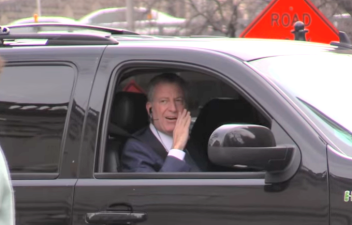KOMANOFF: Restaurant Patio Heaters Will Be a Net Gain for the Climate

The worst thing about Mayor de Blasio’s daily SUV caravan to the Park Slope YMCA was never the carbon emissions, as I made clear in my viral 2017 call-in to the Brian Lehrer show. Rather, it was his pontificating about New York as a climate leader while whistling past the graveyard of deteriorating transit. Badmouthing congestion pricing (which the mayor long did) and gallivanting in a motorized armada presented a perfect storm of climate obliviousness.
Three years on, the mayor’s climate gaslighting continues in his inane daily tweets and dogged refusal to stem the increase in driving, whether through policy or personal subway use. But from time to time, there’s a flicker of progress, as in today’s City Hall declaration that the city’s “Open Streets restaurant” program will be permanent and year-round.
This is good news in several respects: a lifeline for thousands of restaurants; jobs for tens of thousands of restaurant workers and suppliers, as New York Times columnist Ginia Bellafante emphasized today; a rejuvenation of the city’s mojo; and “upstream” reductions in car use as parking spaces and driving lanes reconfigure for outdoor dining.
Of course, autumn and winter restaurant seating requires outdoor patio heaters, which bring greenhouse gas consequences. These vary somewhat, dependent on whether the heaters run on electricity, propane or natural gas. I did a quick computation for gas-fired heaters, and the result was both reassuring and hilarious: operating a gas-fired patio heater sufficient to comfortably accommodate several tables for an entire evening shift releases the same carbon emissions as Mayor de Blasio’s infamous caravan emits each time it conveys him from Gracie Mansion to his Park Slope “Y.”

I did my calculations for a 50,000 Btu/hour Sunglo 50000 BTU Natural Gas Post-Mount Patio Heater With Manual Ignition offered by the BBQGUYS in Baton Rouge. I assumed a four-hour shift and also jacked up the heater’s CO2 emissions an extra 25 percent to reflect leaks of methane, another greenhouse gas, in the natural gas fuel cycle. That single heat lamp, covering a six-foot radius (or 113 square feet, sufficient for three or four two-seat tables or two to three “four tops”), releases 28.2 pounds of CO2 equivalent.
For the mayor’s ride from Gracie Mansion to the Slope, I assumed two SUVs driven 12 miles (just one way) at 20 mpg with “upstream” petroleum refining and extraction adding 20 percent to the direct emissions. The result was also 28.2 pounds of CO2, uncannily matching an evening’s dose of climate pollution from the heat lamp.
But if the respective carbon emissions are identical, the climate implications are anything but. For restaurants, there is literally no alternative to outdoor service so long as pandemic precautions apply.
And eating out is essential to New York’s sustenance, not just for the jobs but for the city’s wherewithal as a social entity. As has been said many times in this space, every family or business retained here, every newcomer or returnee attracted from the suburban or exurban fringe, represents a climate win for “inherently green” Gotham over carbon-profligate Armonk or Arizona. Keeping our restaurants open is key to that.
It is true that carbon emissions from heat-lamping 20,000 restaurants would add up — on the order of a 2-percent rise in citywide vehicle-miles driven, which are roughly 55 million per day — but the aforementioned reductions in driving from removing driving lanes and free parking spaces would absorb much of the increase.
The mayor, of course, has low-carbon alternatives up the wazoo. Instead of being chauffeured halfway across town, he could walk to a nearby Upper East Side gym and later hop on the 4 or 5 at 86th Street for a four-stop ride to work. Or he could ride a bike to City Hall for a bracing, aerobic commute. Or he can vary it up and experience New York City the way most of us do — as pedestrian, cyclist or straphanger (adding an occasional bus or Citi Bike trip in the mix as well).
Any or all of these would pattern not just low-carbon but urban-appropriate commuting. Each could humanize the mayor in the eyes of his constituents while sensitizing him to the highs and lows of getting around not as royalty but as an ordinary person.
Time is running low but it’s not too late. If you spot Mayor de Blasio eating al fresco this fall, give him a thumbs up and, with a smile, say, “Way to go, Mr. Mayor. See you tomorrow on the train or in the bike lane?”
Assumptions for calculation: Heat lamp: 50,000 Btu/hr, 4 hours/day, 51.2 kg CO2 per million Btu of natural gas combusted, 25 percent additional for methane leaks, 2.205 lb per kg; SUV caravan: 19.57 lb CO2 per gallon of gasoline, add 20 percent upstream emissions, 12 mile journey, 20 mpg, two vehicles; 20,000 restaurants: two heat lamps per, which equate to 40,000 “trips to the gym” by two vehicles, or 80,000 vehicle-trips, or 960,000 miles per day, on a citywide base of 55 million vehicle-miles driven per weekday.


